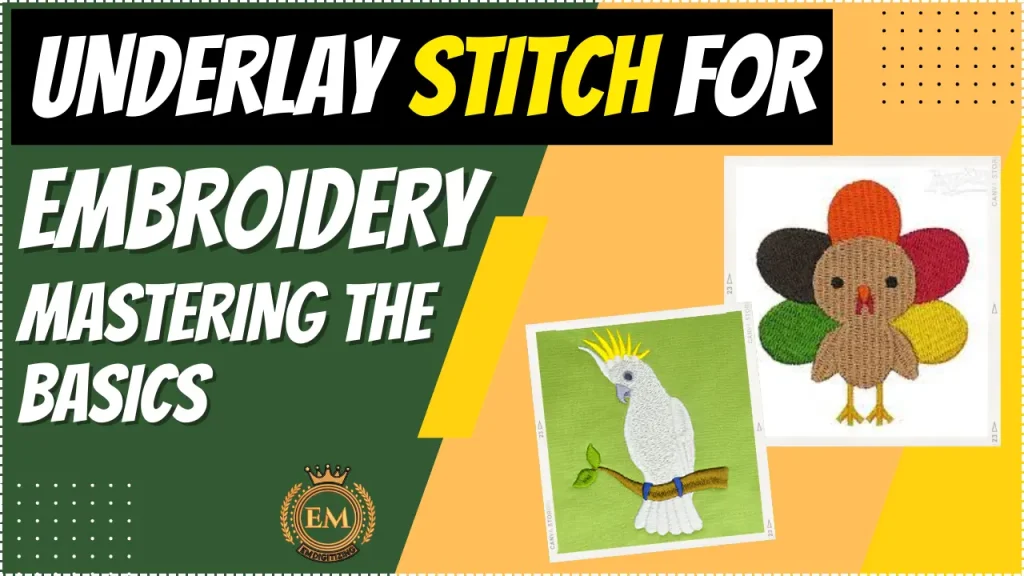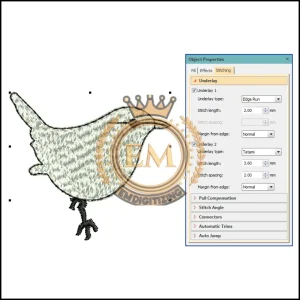If you’re serious about starting your own embroidery business, custom embroidery digitizing is one of the fastest ways to speed up its production time and increase your margin.
In this blog, we’ll discuss why you need custom embroidery digitizing and how it makes the entire process easier and faster.

In this article, we will delve into the underlay stitches for embroidery, exploring its importance, various types, step-by-step techniques, and offering valuable tips to master this fundamental embroidery skill.
Whether you are a beginner or a seasoned embroiderer, understanding and mastering the underlay stitch will undoubtedly elevate the quality and longevity of your machine embroidery creations.
Underlay Stitch For Embroidery: Mastering The Basics
What is Underlay Stitch?
Embroidery is like building a house; you need a strong foundation to ensure longevity and stability. Enter the underlay stitch, the unsung hero of machine embroidery.
The underlay stitch is the first layer of stitches that provides support and structure to your design. It’s like the scaffolding that holds everything together.
Importance of Underlay Stitches for Embroidery
You might be wondering, why do I need this extra layer of stitching?
Well, let me tell you, it’s not just for show. The underlay stitch plays a crucial role in ensuring your embroidery looks top-notch and doesn’t fall apart after a few washes.
Enhancing Design Stability and Durability
Nobody wants their embroidery to sag or lose its shape, right?

That’s where the underlay stitch comes to the rescue. By providing a solid foundation, it helps stabilize the design, making it more durable and preventing any unwanted distortion.
Preventing Fabric Distortion and Puckering
Picture this: you spend hours embroidering a beautiful design on your favorite shirt, only to discover that it looks like a crumpled mess after the first wash.
Yikes!
The underlay stitch can save you from this embroidery nightmare. It helps distribute the tension evenly across the fabric, reducing the chances of puckering or distortion.
Creating Dimension and Texture in Embroidery
Want your embroidery to pop?
The underlay stitch can help you achieve that too.

By strategically adding stitches underneath the main design, it creates depth, and texture, and gives your embroidery a professional finish.
It’s like adding sprinkles to an already delicious cake.
Types of Stitches for Underlay Techniques
Underlay stitch techniques are foundational elements in machine embroidery, serving as the groundwork upon which the final embroidery stitches are applied.
Center Run Underlay Stitch
The center-run stitch is the most common technique. It involves stitching straight lines down the center of each element in your design.

This technique provides stability and is perfect for simple or small designs.
Zigzag Underlay Stitch
For designs with larger areas to cover, the zigzag stitch is your go-to technique.

It adds extra stability by crisscrossing stitches across the design area, preventing any potential gaps or distortion.
Edge Run Underlay Stitch
When it comes to delicate or intricate designs, the edge run stitch is your best friend. It follows the outer edges of the design, creating a supportive border that keeps everything in place.

Fill Stitch Underlay Technique
Got a design that’s mostly filled with stitches?

The fill stitch underlay technique is perfect for you. It adds a solid grid of stitches beneath the fill area, ensuring a smooth and even surface without any puckering.
Combination Underlay Stitch Techniques
Feel like getting fancy?
You can always mix and match different stitch techniques for underlay to suit your design.
Be bold, experiment, and create embroidery magic with a combination of center run, zigzag, edge run, and fill stitch underlay techniques.
Step-by-Step Guide to Mastering Underlay Stitch Techniques
Mastering stitch for underlay techniques is essential for achieving professional-quality embroidery, as these foundational stitches lay the groundwork for the final design, ensuring stability, texture, and dimension.
Preparing the Embroidery Machine and Fabric
Before diving into the underlay stitch, make sure your embroidery machine is set up correctly. Choose the appropriate stabilizer for your fabric and hoop it securely.
Select the desired thread color and load it onto the machine. Prepare your design file, ensuring that the underlay stitch is included in the digitized embroidery pattern.
Setting Up the Underlay Stitch Parameters
Depending on your machine and embroidery software, you may have various underlay stitch options to choose from. Experiment with different stitches densities, types, and angles to achieve the desired stability and texture.
Adjust the stitch length and width if needed. Don’t be afraid to play around and find what works best for your specific design and fabric.
Executing the Underlay Stitch
Once you have selected the appropriate underlay settings, it’s time to let your machine do its magic. Carefully position the needle over the starting point of your design.
Start the embroidery process, ensuring that the underlay stitch is stitched first and covers the entire design area. Take note of the machine’s speed and tension to avoid any issues.
Adjusting and Fine-tuning the Underlay Stitch
After completing the this stitches type, inspect your embroidery design. Check if the fabric is stable, if any show-through is visible, and if the desired dimension and texture have been achieved.
If necessary, make adjustments to the underlay stitch parameters or experiment with additional underlay stitches to perfect your embroidery.
Remember, mastering the underlay stitch takes practice and experimentation. Don’t be discouraged if your first attempts don’t turn out exactly as planned.
Common Mistakes to Avoid When Using Underlay Stitches for Embroidery
Embroidery is a delicate art form that requires precision and attention to detail. When using this stitch in your embroidery projects, it’s important to be aware of common mistakes that can affect the overall quality of your work.
Here are a few pitfalls to avoid:
Using Incorrect Underlay Stitch Type
One of the most crucial decisions when using underlay stitches for embroidery is selecting the appropriate type for your design. Your choice should depend on the fabric, design complexity, and desired outcome.
Using the wrong type of underlay stitch can lead to distorted or uneven embroidery. So, make sure to do your research and experiment to find the perfect match.
Improper Stitch Density
Stitch density plays a vital role in achieving clean and professional-looking embroidery. Too high of a density can cause fabric puckering, while too low can result in a lack of definition.
Finding the right balance is essential for ensuring your underlay stitch provides the necessary support and stability without compromising the design’s aesthetics.
Neglecting Fabric Stretch and Stability
Different fabrics have varying degrees of stretch and stability. Ignoring these factors when applying underlay stitch can lead to distortion, wrinkling, or even the design pulling apart.
Take into account the fabric’s characteristics and adjust your underlay stitch accordingly to maintain the integrity of your embroidery.
Ignoring Tension and Thread Selection
Underlay stitch relies on proper tension and thread selection for optimal results. Incorrect tension can cause thread breakage, looping, or looping on the fabric’s surface.
Likewise, using the wrong thread weight or type can affect the underlay stitch’s effectiveness. Ensure you have the right combination of tension and thread to avoid any pesky embroidery mishaps.
Tips and Tricks for Achieving Professional Results with Underlay Stitch
Mastering underlay stitches or embroidery takes practice and a good understanding of the embroidery process. Here are some useful tips and tricks to help you achieve those professional results:
Experimenting with Different Underlay Stitch Combinations
Don’t be afraid to mix and match underlay stitch types to find the perfect combination for your designs.
Trying out different combinations can enhance the overall stability and visual impact of your embroidery. So, get creative and let your inner stitch explorer run wild!
Understanding the Fabric and Design Requirements
Each fabric and design presents its own set of challenges and requirements. Take the time to understand the fabric’s characteristics, such as stretchiness, density, and texture.
Additionally, analyze the design’s complexity and consider how underlay stitch can best support and enhance it. This understanding will help you make informed decisions and create remarkable embroidery.
Proper Maintenance and Cleaning of the Embroidery Machine
Maintaining and cleaning your embroidery machine regularly is crucial for optimal performance. The buildup of lint, dust, or debris can affect the underlay stitch’s precision and cause embroidery issues.
Take the time to follow the manufacturer’s guidelines for maintenance, ensuring your machine is in top shape for flawless underlay stitch execution.
Utilizing Software Features for Underlay Stitch Optimization
Embroidery software often provides advanced features for optimizing underlay stitch. Explore these tools to leverage their potential and refine your designs.
Features like stitch length adjustment, underlay density control, and stitch direction manipulation can all contribute to enhancing the quality of your underlay stitch.
Conclusion
Mastering the basics of underlay stitches for embroidery with a machine is a valuable skill that can elevate your creations to new heights.
By avoiding common mistakes, implementing effective techniques, and getting creative with underlay stitch applications, you’ll be well on your way to achieving professional-looking embroidery that will leave a lasting impression.
So, embrace the artistry, have fun with your stitches, and let your embroidery shine!
EMdigitizing: Embroidery Digitizing Expert At Your Service
If you are interested in any kind of embroidery project, then EMdigitizing is the best option for you. We offer embroidery digitizing and vector art services with a fast turnaround time. You can also visit and check our website as well as our best services.
We also offer a great 50% discount on all our services for our respected first-time clients. We also offer free quotes generated in just 5 minutes.
You should grab this limited-time offer and take your embroidery project to the next level with EMdigitizing.
If you’ve any queries regarding this topic, you can ask them. Thank you for taking the time to read this article.
Frequently Asked Questions:
Yes, using underlay with 3D satin stitch is beneficial as it provides a stable base, enhancing the texture and volume of the satin stitch, especially in high-density areas or on unstable fabrics.
Underlay stitches are crucial in embroidery for stabilizing the fabric, ensuring the top stitches lie smoothly, and enhancing the overall appearance and durability of the design.
The stitch length for underlay typically ranges from 1.5mm to 2.5mm, depending on the type of underlay and the desired effect on the final embroidery.
The amount of underlay stitches needed in a design varies based on the fabric type, design complexity, and stitch type used; generally, enough underlay is used to provide sufficient stability without causing unnecessary bulk.
